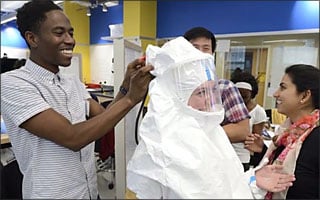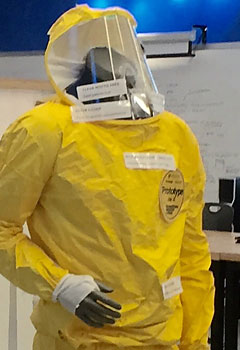An advanced protective suit for health care workers who treat Ebola patients, devised by a Johns Hopkins team in the new BME Design Studio, is one of the first five awardees selected for federal funding in a contest aimed at quickly devising new tools to combat the deadly disease.
The “Fighting Ebola: A Grand Challenge for Development” contest, led by the United States Agency for International Development (USAid), received in excess of 1,500 ideas from innovators around the world.
The Johns Hopkins’ improved health care protective suit grew out of a weekend-long design brainstorming event hosted in October at BME’s Center for Bioengineering Innovation and Design (CBID. The 65 participants represented a wide range of Johns Hopkins students; medical, public health and engineering experts; and even a few community volunteers with valuable skills and perspectives, including a wedding gown designer and an architect.
BME Assistant Professor Youseph Yazdi, challenge organizer and executive director of Johns Hopkins CBID program explained that the goal of the competition was to come up with solutions that could get into the field as quickly as possible, without costing a lot of money. So the team used the same lightweight material that major manufacturers are currently using. But they redesigned it so the hood and the rest of the suit are attached. And they re-positioned a zipper from the front to the back of the suit. They reconfigured the zipper with pull tabs that allow the wearer to unzip easily, so the suit essentially peels away.
“As a result the redesigned suit reduces the number of steps in the doffing process from 20 steps to six, making it much quicker — and safer — to remove.” Yazdi continued, “You don’t need a buddy to help you and you don’t have to touch the hood or grab around your face.”


